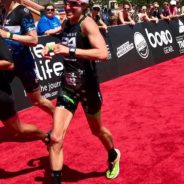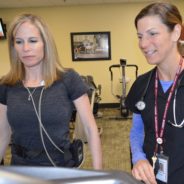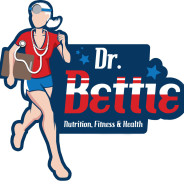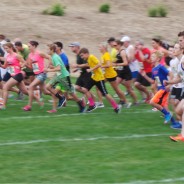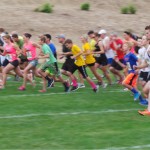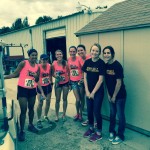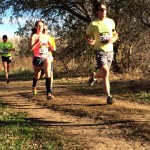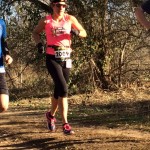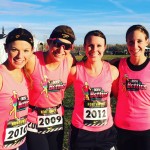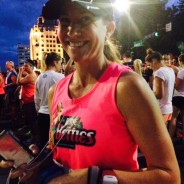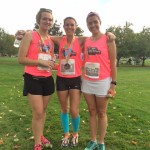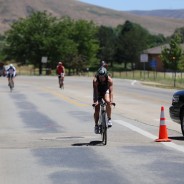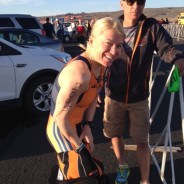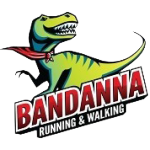Sarah Barber: 2018 Ironman St. George 70.3
Our teammate and fearless track star offers a glimpse at the Half Ironman experience:
Anyone considering a half-ironman triathlon should be forewarned: the race is a logistical nightmare in every way. In other words, the training is the easy part. I was reminded of this fact the day before the 2018 Ironman St. George 70.3. The point-to-point course design meant that most of Friday was consumed with gear drops and familiarization at two different transition zones miles and miles apart. However, I somehow managed to get everything done without completely exhausting myself.
Race morning arrived without any fanfare, and my headspace was good. Unfortunately, things went south immediately after the shuttle bus dumped me and a bunch of nerved-up triathletes at the shore of Sand Hollow Reservoir. I went straight into T1 to visit my bike, which had spent the night there without me, as my first priority was to air up the tires. The valve extender on my deep-dish carbon wheels had never been finicky in the past, but for whatever reason, I could not get the valve open enough to add air—or let air out, for that matter. One of my favorite bike experts (and owner of Tri Town Boise) was on scene to assist, but he was as frustrated as I was. Brainstorming solutions had me running back and forth to tech support, borrowing a different pump, then Bogarting a spare tube. At some point, we learned that my wheel wasn’t a clincher after all, but a tubular, and therefore impossible to replace on the spot.
For a moment, it appeared that I might not even be able to participate in the race, which would have felt almost tragic after devoting the last few months of my life to preparing for it. Good friend and local pro, Erin Green, pointed me toward a woman named Paula, the pro athlete liaison, for emergency assistance. I’m ashamed to admit that I didn’t know until days later that “Paula” was Paula Newby-Fraser, a well-known and highly successful professional triathlete in her day. Anyway, she helped me find a wheel to borrow—a random road bike wheel with a rotor for disc brakes. By some miracle, it fit on my bike without any issue and worked fine with my traditional caliper brakes.
My first crisis was averted with 15 minutes till the start of the race.. During the entire 45 minutes I had spent running all over T1, my second poop of the morning was getting overcooked. In other words, I had to drop a deuce like nobody’s business, and at this point the Porta-Potty lines seemed to go on for miles. Nonetheless, I took a place at the end of the nearest line and spent my wait time peeling on my wetsuit, inch by inch. I landed on a toilet with less than 10 minutes remaining before the start of the race, and was instantly relieved. Until I discovered that there was no toilet paper.
Rummaging through my plastic sack of warm-up clothing, I thoughtfully considered each item. Lululemmon pants? NO way! UpCycle hoodie? Shoot, I really liked that thing… And then I found it: a black wool hat with the word “BACARDI” in bold white caps on the front. It seemed a fitting end for a freebie I’d picked up at an event in Las Vegas years ago.
And then, to the shore of Sand Hollow Reservoir I went. I couldn’t help but think how lucky I was to be able to do this race, despite the issues that had cropped up to sabotage me this morning. The rolling start made for an anti-climactic plunge into the water and smooth sailing initially. The first turn was a traffic jam of bodies on top of bodies, arms and legs flailing all around me, but still survivable. I took the next turn sharply and found a relatively clear line. Looking up once, I saw swim caps and splashes, and was satisfied to follow them. Except then I looked up again and realized that the mob of swim caps was coming at me head-on! I had taken that turn sharply all right—sharply enough that I was paddling back into oncoming traffic. Cursing myself, I altered course and willed my tired arms to propel me back to the shore.
I was elated to exit the water and get on my bike. So much so, in fact, that when I looked down at my watch to assess what I assumed would be an abysmally slow swim time, I saw that I hadn’t even started my watch. #epicfail . Again. But the words of my coach echoed in my mind: “When you get out of the water, and you’re done with your swim, it is what it is. Fuckin’ move on.” His point was that I shouldn’t spend even one second worrying about how fast (or not) my swim had been. So I did what he said. I fuckin’ moved on.
My bike was right where I’d left it, tires still inflated. However, as I rolled out of T1, I could see that my Garmin was displaying time, speed, and distance, but the cadence and power screens were blank. WTF?! I had turned on and calibrated everything before leaving for the swim, and now it was somehow dead? I did everything I could to get it working while pedaling out onto the bike course—turned the Garmin off and on, did a manual search for the power meter, etc—but to no avail. I spent a few minutes feeling absolutely devastated, as my entire race plan was predicated on targeting certain power numbers during the 56 mile leg of this event. Then I refocused and decided to do what I do best: I put my head down and rode fast.
In hindsight, the bike route was made for me. The challenging terrain played to my strengths, and I can honestly say that I enjoyed almost every pedal stroke. Miles ticked away quickly, as the absence of continuous data from my Garmin forced me to tune into my body, constantly assessing my effort. Am I pushing too hard? Could I go any faster? Before I knew it, only a mile or two remained. And those last couple miles saw an uprising of emotion that caught me off guard. I knew I’d see my husband, Brian, at T2 for the first time since I’d left him in bed at 4:40 am when I went to catch the shuttle. I had to swallow the sobs and pull it together, promising myself I could cry all I wanted at the end of the run.
My bike-to-run transition was efficient, highlighted by Brian yelling encouragement and informing me that I was leading my age group. However, I didn’t hear him tell me the margin of my lead, so I took off running scared, resisting the impulse to look over my shoulder. Although this run included a substantial amount of elevation change, I tend to feel like any run in a triathlon is simple. You just have to use whatever energy you have left, and you have to hope you didn’t overdo the bike. I took it one mile at a time, going by perceived effort and checking my pace on my watch only occasionally. Each time I looked, I was moving at a quicker pace than I had hoped. Each time, I gave myself permission to slow down, but I was in a rhythm that couldn’t be disrupted.
My favorite part of the run was that I was finally seeing people I knew who were racing. There were two long out-and-back sections which allowed me to exchange smiles and cheers with friends and Wattie Ink teammates. The sense of family and community overwhelmed and motivated me. Sure, there were some dark moments when I wanted to walk or cry—or both. But I continued to take it one mile at a time, marveling at my body’s ability to do what it was doing. Like a horse drawn to the barn at the end of a long day, I perked up for the remaining miles and got excited about finishing with a total time well under my pre-race goal.
When I crossed the finish line, Brian was there waiting for me, recording the moment on his iPhone, so I hammed it up with a double fist bump to my chest and the words, “Peace out!” I can only think of a handful of times in my life when I was so ready to be finished with some sort of event, but this one topped them all. This was the first time I had to take a few minutes to collect myself with my head buried in Brian’s chest, and then lie flat on the nearest patch of grass until I felt like I could breathe again. If you’d asked me that night if I’d ever do another half-Ironman, I wouldn’t have hesitated in telling you, “Not this year!”
Except I just signed up for another one. And it’s only three weeks away. Because I want another chance to see what it’s like if the run is less hilly. Because I want to see what it’s like to race with power data on the bike. Because I want to use my fast front wheel instead of a borrowed wheel from a kind stranger. Because I have all this fitness and I want to use it on one more big thing before I move on. And because I love this crazy, stupid, complicated sport….
How to Dress For Winter
Good stuff found on the NASM blog, and so very relevant to today’s weather in Boise. Enjoy, Betties and Bettie fans!
By Sam Hutchison CES, CPT, NASM-CPT
The seasons have changed, and for some of us it means below freezing temperatures and snow on the ground—not the most ideal conditions for exercising and physical activity. Fortunately, you don’t have to limit yourself to treadmills, ellipticals and recumbent bikes, exercising outdoors is still a plausible option with some foresight and a plan of action. If you dress properly and follow some easy strategies, you can survive the frigid forefront and exercise at your own discretion.
As humans, our bodies aren’t accustomed to cold climates and take longer to adapt to the cold compared to warmer environments. Biologically humans weren’t designed to live in cold climates; humans lack heavy fur coats and a thick lining like many animals living in colder climates thus making heat production and insulation more difficult. Wearing protective layers is essential to preventing not only a decline in exercise performance but more serious issues such as hypothermia and frostbite.
Effect on Performance
Exercising in cold climates can have inhibitory effects on both cardiorespiratory and strength performance. When exposed to cold environments, the body reduces blood flow to the skin and extremities via vasoconstriction to prevent heat loss and maintain the temperature of the body’s core and vital organs. Due to vasoconstriction and blood cooling, aerobic energy components such as fat and oxygen aren’t as efficiently transported to the muscles for energy production (1). Fuel sources that are typically used for higher intensity training, like muscle glycogen, begin to be used as a replacement, leaving less fuel for later and an earlier onset of fatigue results (2).
When muscle temperatures fall below a certain point, the time for muscles to contract and the amount of muscles recruited (motor unit recruitment) for an activity is compromised (3). This limits the amount of force and power typically seen at more favorable temperatures. If not taken seriously, a decline in performance can lead to frustration and possible injury.
Before You Step Outside
Here are some tips you’ll want to consider implementing before stepping outside to exercise or train. It may not seem like much, but following these tips can make your workouts more enjoyable and ultimately safer.
1. Wear layers: It’s difficult to judge just what to wear when planning on exercising outdoors in the cold. Wearing layers allows you to easily adjust and remove layers of extra insulation as your temperature increases.
2. Remove wet clothing: Water conducts heat much faster than air, so your body loses heat more quickly when clothes are wet. Remove wet clothing to stay properly insulated.
3. Be selective about fabrics: Keeping the skin dry is one of the first layers of defense against the cold. Use a moisture wicking fabric next to the skin; synthetic fabrics and wool dry more quickly than their cotton counterpart. Additional heat can also be lost through wind chill, so make use of wind breaking material on outer layers.
4. Hats, footwear and gloves: As stated earlier, it is important to prevent heat loss and make sure there is optimal blood flow to vital organs and working muscles. The hands, feet, and especially the head are vulnerable areas for heat loss and should be kept insulated. A pair of running gloves, insulating socks, training shoes and a wool/fleece hat can help prevent heat loss.
5. Hydrate, Hydrate, Hydrate: Just like in the heat, it is important to hydrate when cold. You might not realize that you can become dehydrated in the cold since you are sweating less. As you breathe in cold air your body must humidify and warm the inhaled air as it travels to the lungs. This process can dehydrate the body. Drinking a warm beverage before, during and after activity can help fight dehydration and warm the body (4).
It’s unfortunate that we can’t control the weather; a 75-degree day would be a nice break to have in the middle of December. Regardless of your sport or exercise routine, it is important to be able to adapt to changes in weather and develop a plan of action to prevent injury and a decline in performance, even if that might mean taking your training indoors. The winter months and holiday season are not the time to get out of shape. Try following these five simple suggestions and you might just feel like you are working out in that 75-degree weather that you crave.
References
1. Farrell PA, Joyner MJ, Caiozzo VJ. ACSM’s Advanced Exercise Physiology 2nd ed. Baltimore, MD: Lippincott, Williams & Wilkins; 2012.
2. Castellani JW, Young AJ. Health and performance challenges during sports training and competition in cold weather. Br Journ Sport Med (2012);46:788-791.
3. Rome LC. Influence of temperature on muscle recruitment and muscle function in vivo. Am Jorurn Physiol (1990); 259: 210-222.
4. Koskela HO. Cold air-provoked respiratory symptoms: the mechanisms and management. Int Journ of Circ Health (2007); 66(2): 91-100.
Heart & Sole: Survivor’s Perspective on SCAD
Cynthia Mauzerall was planing to race the USATF Cross Country Championships with the Boise Betties’ masters team. Just a month before the race, she suffered a heart attack. It was an incredibly scary time for our team. Here Cynthia shares her perspective on the events immediately following the event.
When I woke up, I saw faces staring at me-friendly, helpful, concerned, surprised. Family members were tearing up and I had no idea why. The only words I could think to say were, “hi” and “what am I doing here?” My husband was told he would be sharing the details with me over and over again until my memory got stronger. When I was informed that I had suffered a Spontaneous Coronary Artery Dissection (SCAD), I wasn’t sure how to wrap my arms around that. Frankly, I thought maybe they made a mistake. I asked myself, “Are they overreacting?” The look on the faces of the team of doctors suggested it was true. Amongst this team of white lab coats was one of my best friends since age 15. Certainly she will tell me what’s what. Dr. Jen (formally known as Dr. Jennifer Anderson) was calm and composed and yet seemed to empathize with how odd all this was to me. She likely knew I had to grasp that this was serious enough that I would not be heading out the door for a run any time soon.
Once the doctors left the room, I searched for evidence. What are all these tubes, catheters, and scars? Family explained that a stent was placed over the dissected artery. I began to feel pain in my chest and ribs. They told me that was CPR that was conducted by 2 everyday heroes at the gym- a retired paramedic and a physical therapist. Slowly I ventured out of detective mode into one of Gratitude. I was grateful for Family and for amazing medical team that despite their current unassuming demeanor had to respond at lightning speed with limited information when I arrived at the ER. I was grateful for those who stepped up and did CPR knowing that it might not make a difference.
The theme of gratitude has been on my mind continually- much because my story was filled with events that now seem rather miraculous. However, I am also grateful for mindfulness and science. Dr. Jen and her team keep abreast of advancements and case studies in Cardiology. In fact, Dr. Jen has been known to stash The New England Journal of Medicine in her bathroom for “easy reading”. A new gratefulness has emerged for curiosity and mindfulness. Dr. Jen has reiterated that we are experts on what are bodies are communicating to us. We need to listen, to be curious, to ask questions. I had ben slowing down substantially on my runs and workouts but felt foolish mentioning it to anyone. I felt lucky to be as active as I am at 42. I could have simply said, “Maybe this is nothing, but….” We don’t have to be MDs to be mindful of our bodies, and what they communicate to us. There are folks out there like Dr. Jen whose passion is to understand what the symptoms mean, we just have to vocalize those symptoms.
Heart & Sole: The Betties to Run for Women’s Heart Health Awareness
The phone call came on what seemed to be an otherwise typical busy day in the hospital. “I’ve got a bit of an unusual case here, ” the emergency room physician began. “A 42 year-old woman was found down at the gym…”
I had a fleeting thought of “jeez, I hope I don’t know her”, but refocused my attention on the rest of my colleague’s information. This certainly was an unusual case… He described her as a fit looking woman, who had no signs to suggest that she otherwise had a heart problem. However, we both had a high level of suspicion that she may have suffered a heart-related event.
We made a quick plan over the phone, and I immediately headed to the emergency room to take a look at her. It was moments later that yes, indeed, our Jane Doe was someone that I knew. But not only was she someone that I knew… she was one of my closest friends.
It is always difficult to see individuals arrive in such a critical state of illness. They have wires and tubes attached to their bodies. Though they are draped hastily in a hospital gown, there is no room for modesty, and some level of unintentional exposure is inevitable. There may be bruises or blood. They may be agitated and moving their limbs in awkward and uncoordinated ways. This was not the way my friend was supposed to look. Even though I knew she was not in a state to hear me, I promised her that we would sort this out. I swiftly placed a hollow tube into her artery and thread my way to the blood vessels supplying her heart. When the dye that illuminated her arteries clearly suggested the culprit, I must admit that I felt some level of shock: My friend had, indeed, experienced a heart attack.
Recent studies suggest that we are becoming more aware of the fact that heart disease remains the number one killer of women in America. While one in 31 women dies from breast cancer each year, heart disease claims the lives of one in three. This is equivalent to roughly one death each minute. Unfortunately, studies also suggest that younger women are less aware of the importance of heart disease compared to older women. This is extremely important, as heart disease affects all ages, and raising awareness may save lives.
Like my friend, heart disease can affect healthy, fit individuals who abide by good eating habits and have never smoked a cigarette. Yet there are other more subtle risk factors, such as knowing your family history and your blood cholesterol numbers, that are important to recognize. It is also important to understand that symptoms of heart disease may be atypical – and may be mistaken for anxiety, gut pain, or just general fatigue. We need to listen to our bodies. We need to listen to each other. We need to know our own risk factors, and we need to discuss these with our medical providers.
It is with great relief, awe and gratitude that I can share my friend’s story and her happy ending. She is now home with her beautiful family, and her heart is beginning to heal. She has returned to work, and has started some light exercise with our cardiac rehabilitation program (which she described to me as “fun”). She continues to inspire us all, and has generously agreed to share her story with our community. This weekend, the USATF Cross Country National Championship running races will be held in Bend, Oregon, and our own Boise Betties women’s running team will be racing in her honor – and to raise awareness of heart disease for all women, young and old.
Dr. Jennifer S. Anderson, MD, PhD, FACC is a cardiologist at Saint Alphonsus Heart Institute. She specializes in exercise and sports cardiology, women’s heart care, prevention and lipid management.
An Awesome Partnership with St. Luke’s Sports Medicine
The Boise Betties are super excited to announce that we have been selected by St. Luke’s Sports Medicine as a sponsored team in 2016! This is an incredible partnership for our athletes to stay on top of injury prevention and care- a must for any level of athlete!
What does this mean for the members of our running club? It means that the physical therapists at St. Lukes Orthopedic Rehabilitation gave us an inside line for booking appointments; a chance to nip an injury in the bud. If injury does set in and our athletes need a cross training option, St. Luke’s has granted us complimentary hours each week on the AlterG treadmill (antigravity treadmill: basically the best thing an injured runner could hope for). But best of all, our athletes will prevent injuries with the help of comprehensive gait analysis by the pro’s in the sports medicine department.
Imagine running on a treadmill, in front of a large grid with little dots stuck on your knees and hips- actually dots on every joint- all in the name of identifying weaknesses in your running form! Subtle hip drops and twisting torsos will no longer aggravate our Betties to the point of injury. This is a very cool chance for our team to gain personal insight at a level many elite runners have not yet experienced. As a new offering at the clinic, we are thrilled to be some of the first in line for the service!
2016 is going to be a great year for our healthy, strong, and balanced Betties! Thank you St. Lukes!
Community XC in Boise
With just 3 community races, the Betties made a decent showing at each. As we prep for the USATF National Championships in Bend next February, we have to get our racing legs under us where we can. Here are a few photos from the awesomely fun XC races Boise offers!
- Go team! #BettieUp
- Mass Start
- Gretchen & Shea
- Sarah & Sarah
- Sarah, Sarah & Candace- working together!
- post race blisters :/
- Podium!
- Jen @ CB Park
- Racing the kids to the finish
- Gretchen @ CB Park
- Erica winning NXR West
- Becca @ NXR West
- Shea @ NXR West
- Sarah @ NXR West
- NXR West Regional Championships
AG win at Boise 70.3
Sarah Barber has been a cyclist for many years – and very successful in the sport. She joined the Boise Betties this spring and began working on her running. I was impressed from the start by her work ethic and athletic abilities.
When she mentioned the possibility of competing in the Boise half Ironman – rumored to be the last Boise Ironman event – I encouraged her as strongly as I could. She was on the fence but her Bettie teammates I wanted to see her give the event a try.
Needless to say, Sarah had an incredible debut in the half Ironman. She won her age group and powered through the heat. It was an incredible race. Congratulations Sarah!!

📷: David Meadows
📷: David Meadows
Sawtooth Relay 2015
so proud to announce that the Boise Betties ran hard, had fun, and supported each other to a first place finish! Congrats ladies!!!!
Here are a few photos from the day, mostly in reverse order :/ 🙂
Ironman 70.3 in St. George
The stories are coming, but the photos are here. Barkley got after her first Ironman in style, despite an epic flat and desert heat.



